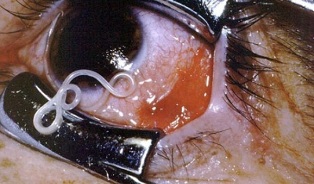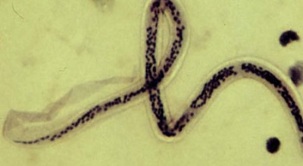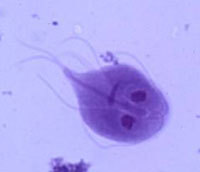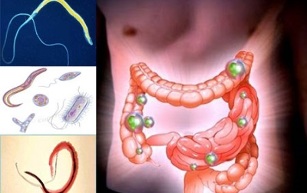
In biology, organisms that carry out their vital activity at the expense of another organism of another biological species are considered parasites.
This vital activity of the parasite does not bring any benefit to the host organism and, in the best of cases, the interaction does not lead to the development of negative effects.
In the worst case, the parasite kills the host. In this case, the parasite escapes to the external environment or joint death.
Parasitic diseases of humans have been known practically since the earliest era of human existence. This fact was established in the process of observing the behavior of direct human ancestors: the apes. The parasites that inhabit the wool are detected by the monkeys and they kill each other. This process has a very important character of social interaction.
Human intolerance to the appearance of pimples and holes on the skin also dates back to the early era of human existence. Some parasitic insects in tropical areas can deposit their larvae on the skin. This leads to a reflex urge to squeeze them out of the skin.
Ancient scientists described various worms that affected the eyes, skin, and gastrointestinal tract. In the 18th and 19th centuries, with the development and introduction of microscopy into medical practice, scientists established the causes and routes of transmission of parasites that can cause specific diseases in humans.
- The beginning of the 20th century and the discovery of antiparasitic agents enabled humanity to deal with most parasitic diseases.
Therefore, humanity lives very closely with various parasites almost throughout its history. However, modern medical science makes it possible to diagnose the entire spectrum of parasites quickly and fairly accurately, giving doctors the opportunity to treat such diseases in the shortest possible time and with minimal risks to patients.
The GP will help to identify parasites in the human body, symptoms and treatment. Sometimes infectious disease specialists of a more limited specialization, parasitologists, can participate for this.
What are parasitic diseases?

Parasitic diseases are nosologies that arise after the introduction (invasion) of biological agents into the body. The latter refer to the group of human parasites. The symptomatology of such diseases is extremely diverse and depends precisely on the agent that has taken root and carries out its vital activity in the body.
According to the way parasites affect the human body, they are generally divided into the following groups:
- Exo-parasites that affect human skin and hair.
- The toxic effect of the parasite's waste products on the body.
- Damage to the mucous membranes of the gastrointestinal tract and lungs by a parasite.
- Formation of cysts and cysts in human organs. An increase in the size of such cysts and cysts leads to specific symptoms of organ compression.
- Disruption of the normal passage of food through the gastrointestinal tract. This can lead to intussusception (more often in children) or the development of intestinal obstruction.
- Parasites that live inside a person can cause sensitization and the appearance of nonspecific allergic reactions.
- Microparasites can disrupt the functioning of blood cells and cause fever and intoxication.
- The effect of certain types of parasites on the body not only produces severe symptoms, but can also lead to organ failure or death.
Such a variety of negative effects of parasites that arise in the body is due to the different biological species that are introduced into human organs. However, such biological diversity of parasites living in the human body allowed doctors to identify specific signs of parasitic diseases.
Parasites that live in the human body

The main forms of human infection by parasites depend on the life cycle of the biological organism, which is the causative agent of the parasitic disease.
Doctors identify ways in which the parasite enters a person as:
- Contact path.It is characteristic of exoparasitic insects, as well as some helminths that live mainly in water, whose larvae penetrate under the human skin. You can be infected in this way both by a sick person and by contaminated bedding, bedding, personal or public hygiene items, etc.
- Fecal-oral routeof infection. It occurs when the pathogen's cysts enter the food after contact with infected feces, mainly from animals. Also, self-invasion can be observed - self-infection of a person if personal hygiene is not observed, etc.
- Contamination.The pathogen enters the bloodstream when infected insects are squashed.
- Transmissive infection.The parasite enters the bloodstream when bitten by an insect carrying the disease. Most often, this route of transmission is characteristic of the simplest parasites, for example, malaria.
- Sexually transmitted infection.It is characteristic of both venereal diseases caused by parasites and some helminths that can affect the urinary and genital tracts of a person.
Protozoa, helminths (round and flat worms), insects and some types of fungi are attributed to the causes of parasitic diseases.
The presence of humans with these species depends on the geographical and climatic zone. Therefore, the medicine of each country keeps its own records and a list of parasites that are specific to it.
Biological organisms that enter the human body have been studied in detail by both medical biologists and physicians, which made it possible to clearly classify all biological species that can cause parasitic diseases:
- The simplest organisms (amoebiasis, balantidiasis, babeosis, Chagas disease, leishmaniasis, malaria, giardiasis, trypanosomiasis, toxoplasmosis, trichomoniasis).
- Helminths. The term worms is sometimes used (ascariasis, dichroceliosis, diphyllobothriasis, dranculosis, clonorchiasis, opisthorchiasis, strongyloidiasis, taeniasis, fascioliasis, schistosomiasis, enterobiasis, echinococcosis).
- Exoparasites (lice (pubis, head, clothing), demodicosis, fleas, bed bugs, scabies).
Signs of parasites in the human body

Unfortunately, there are no exact signs of parasites in the human body and no symptoms that indicate this or that type of parasite infection. This leads to the fact that for an accurate diagnosis, for example, helminthiasis, specific tests are needed.
On the other hand, almost all exo-infections are diagnosed quite simply, based on the clinical picture and the presence of a certain type of insect on the skin.
In general terms, all the symptoms of parasitic diseases can be grouped into the following groups:
- Itchy skin and discomfort caused by external parasites of the hair and skin (fleas, lice and others). An itchy, acne-like rash is often associated with a condition such as demodicosis (a special type of mite).
- Pain in various parts of the body caused by the introduction of a parasite into the skin and muscles (some types of worms that live in water).
- Pain in the eyes, blurred vision.
- Pain in the lungs, coughing up phlegm (this situation can be typical of the migration of roundworm larvae into the lungs, as well as with echinococcal cysts of the lungs, etc. ).
- Nausea, vomiting, and diarrhea are very common symptoms of most helminths that parasitize the digestive tract.
- Jaundice, liver and biliary tract disorders, liver failure. These symptoms occur with helminths that affect the liver and bile ducts, as well as with malaria at the height of the disease.
- Stomach pain.
- Intestinal obstruction due to the closure of the intestinal lumen with a large number of roundworms or large representatives of flatworms.
All these symptoms of the presence of parasites in the human body, in the absence of data for another pathology, should lead the doctor to think about a parasitic disease in humans and serve as a basis for diagnostic and laboratory studies.
Diagnosis of parasites in humans
Depending on the type of parasite that has invaded the human body, one or another investigation is carried out. If we talk about ex-external parasites, which are mainly insects, then the diagnosis of the disease is usually limited to a general examination, as well as insect microscopy.
The general examination generally provides an accurate diagnosis and proper treatment or disinfection of the scalp or skin. In the case of demodicosis or scabies, the diagnosis can be easily established based on the location of the rash and the presence of itching.
The scrapings taken for microscopy in this case confirm the diagnosis of intradermal parasites.
For gastrointestinal parasites, the main screening study (a diagnostic procedure that allows you to quickly and relatively informatively assess data on the presence or absence of the disease in large numbers of people) is the analysis of thefeces.
- With a special microscopic examination of the stool, the laboratory assistant evaluates the presence of worm eggs, dead helminths, cyst capsules, etc.
By the morphology of helminth eggs, you can determine with almost precision the type of worm that parasitizes on the body. Sometimes in feces, tapeworm segments are determined macroscopically. They are then examined under a microscope to establish the appearance of a parasitic flatworm in the gastrointestinal tract.
In some cases, for example, when the diagnosis of parasites in the body is impossible by stool analysis or not informative, immunological studies are used. They allow you to evaluate the presence of antibodies against a particular type of helminth. Unfortunately, due to the special immunological relationship between the human immune system and the parasite, the level of antibodies in some cases may not reflect the true picture of the disease.
In the case of malaria, a thick drop of blood is tested for Plasmodium malaria. In addition, general blood counts, leukocyte levels, and all biochemical parameters of the blood are evaluated, especially the liver.
The presence of an elevated level of eosinophils in the blood is a frequent sign not only of allergic diseases, but also of helminthic invasions. This is the first "bell".
Sometimes helminths in the gastrointestinal tract are a diagnostic finding during contrast radiographs, cystoscopy, FGDS, colonoscopy.
How to get rid of parasites in the human body?

Treatment of parasitic infections should only be done by a doctor, subject to certain rules.
Self-medication and traditional medicine in such cases do not improve and can sometimes be fatal.
It is also important to provide preventive treatment to all family members and contacts.
Human exoparasites, which parasitize the hairy areas of the body, are destroyed with special disinfectants. Generally, a single treatment followed by a hygienic scrub is sufficient to remove the exoparasites.
When it comes to skin types of parasites (scabies, demodicosis), use special ointments that contain insecticides against these organisms.
Anthelmintics are used against round and flat worms, which act in the main lumen of the gastrointestinal tract specifically on helminths. Depending on the biological type of helminths, various treatment regimens are used (from one tablet to a series of courses).
Such drugs should be used strictly under the supervision of a doctor in order to timely recognize the negative effects and side effects of the drugs.
No other treatment method, detox program, etc. it can lead to the complete death of parasites in the body and, as a result, to the healing of a person.



























